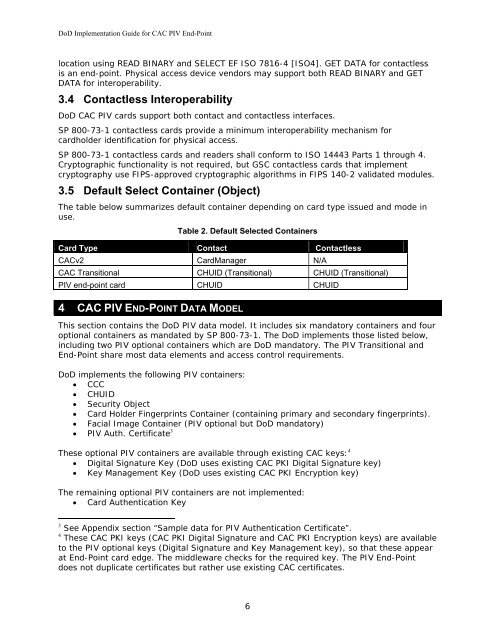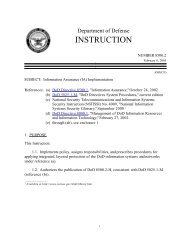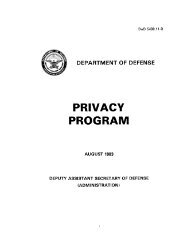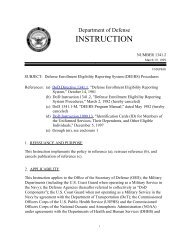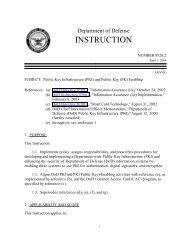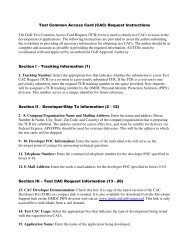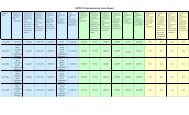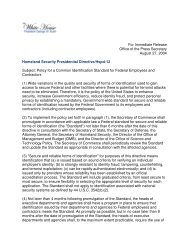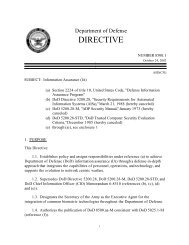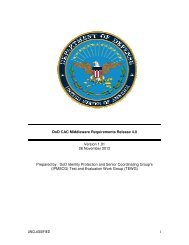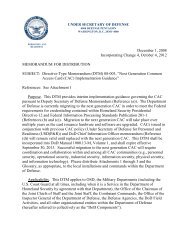DoD Implementation Guide for CAC PIV End-Point - Common ...
DoD Implementation Guide for CAC PIV End-Point - Common ...
DoD Implementation Guide for CAC PIV End-Point - Common ...
You also want an ePaper? Increase the reach of your titles
YUMPU automatically turns print PDFs into web optimized ePapers that Google loves.
<strong>DoD</strong> <strong>Implementation</strong> <strong>Guide</strong> <strong>for</strong> <strong>CAC</strong> <strong>PIV</strong> <strong>End</strong>-<strong>Point</strong><br />
location using READ BINARY and SELECT EF ISO 7816-4 [ISO4]. GET DATA <strong>for</strong> contactless<br />
is an end-point. Physical access device vendors may support both READ BINARY and GET<br />
DATA <strong>for</strong> interoperability.<br />
3.4 Contactless Interoperability<br />
<strong>DoD</strong> <strong>CAC</strong> <strong>PIV</strong> cards support both contact and contactless interfaces.<br />
SP 800-73-1 contactless cards provide a minimum interoperability mechanism <strong>for</strong><br />
cardholder identification <strong>for</strong> physical access.<br />
SP 800-73-1 contactless cards and readers shall con<strong>for</strong>m to ISO 14443 Parts 1 through 4.<br />
Cryptographic functionality is not required, but GSC contactless cards that implement<br />
cryptography use FIPS-approved cryptographic algorithms in FIPS 140-2 validated modules.<br />
3.5 Default Select Container (Object)<br />
The table below summarizes default container depending on card type issued and mode in<br />
use.<br />
Table 2. Default Selected Containers<br />
Card Type Contact Contactless<br />
<strong>CAC</strong>v2 CardManager N/A<br />
<strong>CAC</strong> Transitional CHUID (Transitional) CHUID (Transitional)<br />
<strong>PIV</strong> end-point card CHUID CHUID<br />
4 <strong>CAC</strong> <strong>PIV</strong> END-POINT DATA MODEL<br />
This section contains the <strong>DoD</strong> <strong>PIV</strong> data model. It includes six mandatory containers and four<br />
optional containers as mandated by SP 800-73-1. The <strong>DoD</strong> implements those listed below,<br />
including two <strong>PIV</strong> optional containers which are <strong>DoD</strong> mandatory. The <strong>PIV</strong> Transitional and<br />
<strong>End</strong>-<strong>Point</strong> share most data elements and access control requirements.<br />
<strong>DoD</strong> implements the following <strong>PIV</strong> containers:<br />
• CCC<br />
• CHUID<br />
• Security Object<br />
• Card Holder Fingerprints Container (containing primary and secondary fingerprints).<br />
• Facial Image Container (<strong>PIV</strong> optional but <strong>DoD</strong> mandatory)<br />
• <strong>PIV</strong> Auth. Certificate 3<br />
These optional <strong>PIV</strong> containers are available through existing <strong>CAC</strong> keys: 4<br />
• Digital Signature Key (<strong>DoD</strong> uses existing <strong>CAC</strong> PKI Digital Signature key)<br />
• Key Management Key (<strong>DoD</strong> uses existing <strong>CAC</strong> PKI Encryption key)<br />
The remaining optional <strong>PIV</strong> containers are not implemented:<br />
• Card Authentication Key<br />
3 See Appendix section “Sample data <strong>for</strong> <strong>PIV</strong> Authentication Certificate”.<br />
4 These <strong>CAC</strong> PKI keys (<strong>CAC</strong> PKI Digital Signature and <strong>CAC</strong> PKI Encryption keys) are available<br />
to the <strong>PIV</strong> optional keys (Digital Signature and Key Management key), so that these appear<br />
at <strong>End</strong>-<strong>Point</strong> card edge. The middleware checks <strong>for</strong> the required key. The <strong>PIV</strong> <strong>End</strong>-<strong>Point</strong><br />
does not duplicate certificates but rather use existing <strong>CAC</strong> certificates.<br />
6


